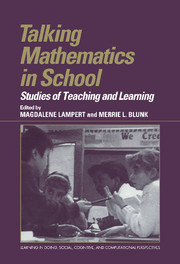Book contents
- Frontmatter
- Contents
- Series Foreword
- Acknowledgments
- List of Contributors
- 1 Introduction
- Part I Doing and Learning Mathematical Talk
- Part II Teaching Mathematical Talk
- 6 Investigating Teaching Practice
- 7 The Teacher's Role in Mathematical Conversation: Stepping In and Stepping Out
- 8 Teacher Talk About How to Talk in Small Groups
- 9 Teaching and Learning Politeness for Mathematical Argument in School
- Afterword
- Author Index
- Subject Index
7 - The Teacher's Role in Mathematical Conversation: Stepping In and Stepping Out
Published online by Cambridge University Press: 04 August 2010
- Frontmatter
- Contents
- Series Foreword
- Acknowledgments
- List of Contributors
- 1 Introduction
- Part I Doing and Learning Mathematical Talk
- Part II Teaching Mathematical Talk
- 6 Investigating Teaching Practice
- 7 The Teacher's Role in Mathematical Conversation: Stepping In and Stepping Out
- 8 Teacher Talk About How to Talk in Small Groups
- 9 Teaching and Learning Politeness for Mathematical Argument in School
- Afterword
- Author Index
- Subject Index
Summary
This chapter is about the role of the teacher in helping students learn mathematics. While that statement may sound rather straightforward, it isn't. That's because what I mean by mathematics may not be the same as what others mean when they think “mathematics.” So, before I discuss the teacher's role in mathematics learning, I'd like to discuss what I mean by mathematics. In order to do that, I'm going to back up even further and discuss a term that may at first seem unrelated to mathematics: literacy. As I hope will soon be clear, understanding literacy is fundamental to understanding mathematics, as well as the role of the teacher in mathematics learning.
Understanding Literacy
When many people think about literacy, they think “reading and writing.” This seems logical; after all, variations of this definition have been with us since the Middle Ages (Venezky, 1991). But defining literacy as “the ability to read and write” (American Heritage Dictionary, 1983) becomes problematic when literacy situations are examined. Does literacy include oral language, as when a group of people discuss a written text, or is literacy limited to an individual's silent interaction with written language? Does literacy deal only with issues related to those disciplines associated with reading and writing, or does literacy encompass other disciplines like science and mathematics? After all, people do read and write about issues like chaos theory, fractals, and the 25%-off sale at the local mall.
- Type
- Chapter
- Information
- Talking Mathematics in SchoolStudies of Teaching and Learning, pp. 163 - 189Publisher: Cambridge University PressPrint publication year: 1998
- 20
- Cited by

